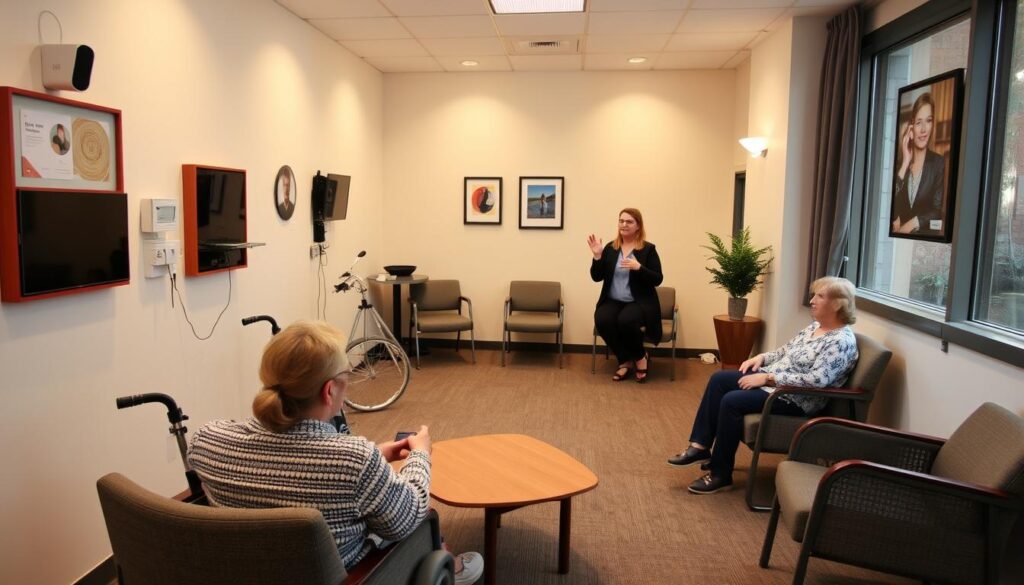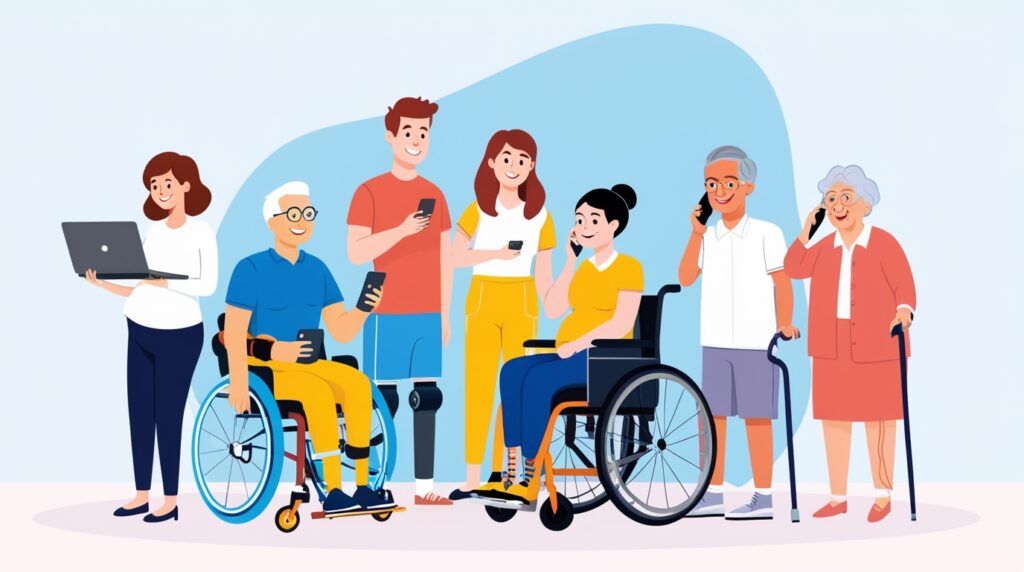Do You Know About the Many Accommodation for Hearing Impaired? Explore Assistive Listening Devices and Captioning Services.These options help everyone join in, whether at school, work, or social events.
In this guide, we’ll look at key accommodations. They can make a big difference in the lives of those with hearing challenges. This way, they can do well in different areas of life.If you or someone you know experiences hearing issues and seeks a product that addresses tinnitus and improves hearing clarity, consider exploring this solution.
Key Takeaways
- The Americans with Disabilities Act (ADA) and Rehabilitation Act require institutions to provide reasonable accommodations for the hearing impaired upon request.
- Common accommodations include sign language interpreters, speech-to-text services, assistive listening systems, note-taking services, and captioned media.
- Assistive listening systems like FM/DM, infrared, and induction loops enhance sound clarity for those with hearing impairments.
- Captioning media benefits a wide range of individuals, including deaf students, visual learners, and non-native English speakers.
- Educational institutions and workplaces must ensure accessible communication and promote a culture of inclusivity for the hearing impaired.
Understanding Hearing Impairment and the Need for Accommodations
Hearing impairment covers a wide range, from mild loss to deep deafness. It’s key to understand the needs of those with hearing loss to help them communicate well. This is vital in places like schools and workplaces.
Types of Hearing Impairments
There are different types of hearing loss. Sensorineural loss affects the inner ear or nerve. Conductive loss is about the outer or middle ear. Mixed loss combines both.
People with hearing loss might call themselves deaf or hard of hearing. Those who use Australian Sign Language (Auslan) often say they are deaf.
Importance of Effective Communication
Good communication is vital for those with hearing loss. Students might need special seating or devices to hear better. They might also need sign language interpreters or live captions.
Teachers can help by arranging seats and using devices. They should also keep noise down and provide written materials. This helps students with hearing loss feel included and learn better.If you’re seeking a solution for tinnitus that promotes better brain function and hearing, explore the product featured here.
Interpretation Services for the Hearing Impaired
For those with hearing impairments, interpretation services are key for clear communication. American Sign Language (ASL) interpretation uses hands, arms, and facial expressions to convey messages. It’s vital for the deaf and hard of hearing to fully engage in education and work.
Other services like oral transliteration and cued speech transliteration offer different ways to communicate. They meet the varied needs of the hearing impaired, making sure everyone can get the information they need.
American Sign Language (ASL) Interpretation
ASL interpretation is the most recognized for the hearing impaired. ASL interpreters are experts in both ASL and English. They help connect people who use ASL with those who don’t.If you’re exploring advanced solutions for hearing clarity, including a product that promises relief from tinnitus, check out more information here.
They’re needed in schools, hospitals, government offices, and meetings. Remember, sign language interpreting services should be booked 2 weeks before an event to ensure they’re available.
Oral Transliteration and Cued Speech Transliteration
Oral transliteration and cued speech transliteration are also crucial. Oral transliteration helps those who lip read by repeating words clearly. Cued speech uses hand shapes to represent sounds, helping with understanding spoken language.
These services are great for those who don’t use ASL or need something different. They make sure the hearing impaired have many ways to communicate.
It’s important for those with hearing impairments to have access to skilled interpreters. They help ensure everyone can fully participate in various settings.
accommodation for hearing impaired
For those with hearing impairments, assistive listening devices and speech-to-text services are key. They make communication better and life easier. They also help meet the Americans with Disabilities Act (ADA) and make places more welcoming.
Assistive Listening Devices and Systems
Devices like FM systems, infrared systems, and induction loops help a lot. They make sound clearer and cut down on background noise. This lets hearing-impaired people get the audio they need more easily.Additionally, those experiencing tinnitus or hearing loss can benefit from a solution that enhances hearing while improving brain function. Learn more about this option here.
Speech-to-Text and Captioning Services
Speech-to-text and captioning services are also very important. They include CART, TypeWell, and C-Print. These services give real-time text of what’s being said. This way, hearing-impaired people can join in on talks, meetings, and events.
| Assistive Listening Devices | Speech-to-Text Services |
|---|---|
| FM systems Infrared systems Induction loops | Communication Access Real-Time Translation (CART) TypeWell C-Print |
Using these tools, places can make sure everyone gets the same chance to hear and join in. This is true for work, school, and public events.

“Accommodating individuals with hearing impairments is not only a legal requirement but also an opportunity to foster a more inclusive and accessible environment for all.”
Creating an Inclusive Environment
Making spaces inclusive for those with hearing impairments is key, in schools and workplaces. By setting up classroom accommodations and workplace accommodations, we help everyone join in and succeed.To further enhance your hearing experience and address tinnitus, explore the product highlighted here.
Classroom and Workplace Accommodations
In class, good accommodations might be:
- Seating students up front for better sight
- Using visual aids like captioned videos and slides
- Helping with notes, including tech tools
- Adapting tests and exams
At work, accommodations could be:
- Improving the space with better lighting and sound
- Using tools like assistive listening devices
- Training coworkers to work well together
- Working with disability services for more support
Promoting Accessibility and Awareness
To really make a place inclusive, we need more than just accommodations. We must:
- Teach and educate everyone to be more aware and understanding
- Stand up for the rights and needs of those with hearing loss
- Work with experts to keep making things better for everyone
By doing these things, we can make a place where everyone feels welcome and valued. It’s about celebrating our differences and making sure everyone has a fair chance.
Conclusion
In this guide, we’ve explored key accommodations for individuals with hearing impairments, emphasizing the importance of inclusive communication and advanced technologies. Accommodating those with hearing loss not only meets legal requirements but also creates a more welcoming environment for all. From assistive listening devices to speech-to-text services, there are many tools available to enhance the lives of those with hearing challenges.
If you’re dealing with hearing impairments or tinnitus, consider exploring a solution that promises no more whooshing, buzzing, or clicking, while improving overall brain function. Learn more about how you can enhance your hearing experience here.
Take the next step toward fostering inclusivity and supporting those with hearing challenges, and don’t forget to explore the benefits of advanced hearing solutions today!
Check out This Post: https://healthsuccesful.com/choosing-the-right-ear-protection-for-concerts-and-events/
FAQ
What are the different types of hearing impairments?
Hearing impairments vary from mild to profound deafness. It’s important to understand these differences. This helps us provide the right support to the hearing impaired community.
Why is effective communication important for individuals with hearing impairments?
Good communication is key for those with hearing impairments. It lets them join in fully in school and work. Making communication accessible helps everyone feel included.
What are the different types of interpretation services available for the hearing impaired?
There are several interpretation services. These include American Sign Language (ASL), oral transliteration, and cued speech transliteration. They meet the different needs of the hearing impaired community.
What are the assistive listening devices and systems available for the hearing impaired?
There are many devices and systems to help. FM systems, infrared systems, and induction loops make sound clearer. Speech-to-text and captioning services, like CART, TypeWell, and C-Print, provide live text of what’s being said.
What accommodations can be provided in educational and professional settings for the hearing impaired?
Many accommodations are possible. These include seating near the front, visual aids, and help with notes. Testing can also be adjusted. Training and working together with disability services can make places more welcoming.
Source Links
- Access & Accommodations – https://nationaldeafcenter.org/resources/access-accommodations/
- Accommodations for Students who are Deaf/Hearing Impaired – Guide to Accommodating Students with Disabilities – Virginia Western Community College – https://www.virginiawestern.edu/faculty-staff/disability-accommodations/hearing-impaired/
- Inclusive Teaching: Deaf and Hard of Hearing – https://www.adcet.edu.au/inclusive-teaching/specific-disabilities/deaf-hearing-impaired
- Documentation Guidelines: Hearing Impairment – Accommodations – https://accommodations.collegeboard.org/request-accommodations/provide-documentation/by-disability/hearing-impairments
- MedEd Connections Resource Guide: Deaf and Hard of Hearing (D/HH) – https://deafandblindoutreach.org/meded-connections-dhh/meded-dhh-accommodations-and-modifications
- Accessible Services for Deaf and Hard of Hearing Individuals – https://www.commerce.gov/cr/programs-and-services/accessible-services-deaf-and-hard-hearing-individuals
- Communicating with People Who Are Deaf or Hard of Hearing in Hospital Settings – https://archive.ada.gov/hospcombr.htm
- Hearing Disabilities in the Workplace and the Americans with Disabilities Act – https://www.eeoc.gov/laws/guidance/hearing-disabilities-workplace-and-americans-disabilities-act
- Hearing Impairment – https://askjan.org/disabilities/Hearing-Impairment.cfm
- 12 Ways to Make Classrooms Accessible for Deaf & Hard-of-Hearing Students – https://www.ava.me/blog/12-ways-to-make-your-classroom-accessible-for-deaf-and-hard-of-hearing-students
- 7 Ways to Create Inclusive Workplaces for Deaf Employees – https://www.adeccogroup.com/future-of-work/latest-insights/7-ways-to-create-inclusive-workplaces-for-deaf-employees
- Classroom Accommodations for Children with Hearing Loss – https://www.stacycrouse.com/post/classroom-accommodations-for-children-with-hearing-loss
- What Are Hearing Loss Accommodations? – https://www.springhills.com/resources/hearing-loss-accommodations



